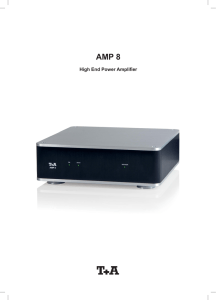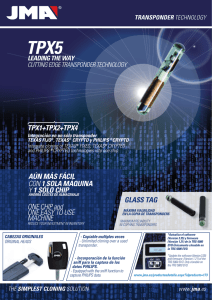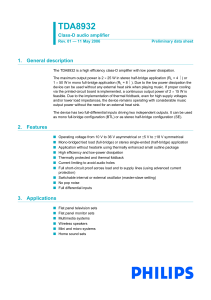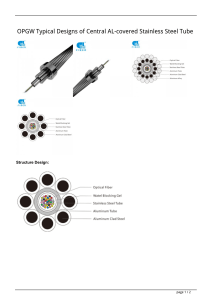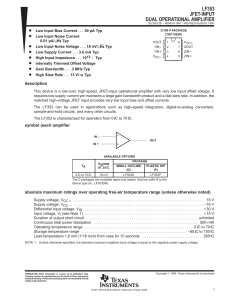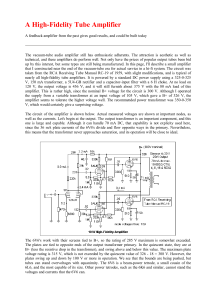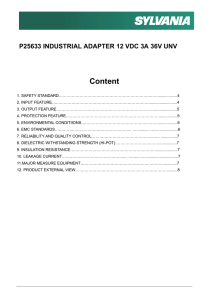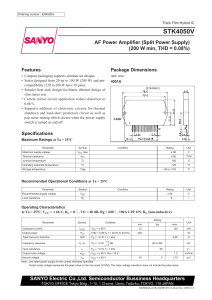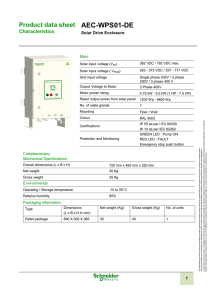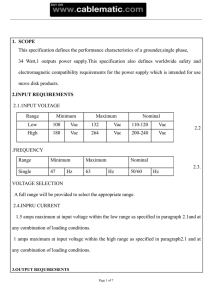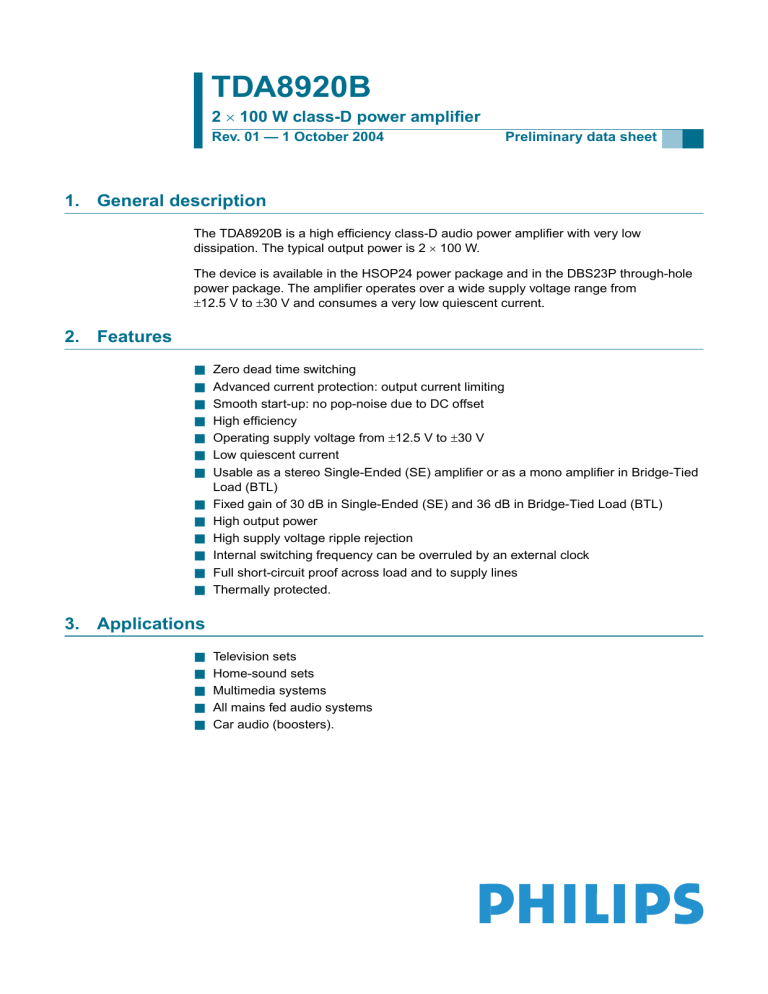
TDA8920B 2 × 100 W class-D power amplifier Rev. 01 — 1 October 2004 Preliminary data sheet 1. General description The TDA8920B is a high efficiency class-D audio power amplifier with very low dissipation. The typical output power is 2 × 100 W. The device is available in the HSOP24 power package and in the DBS23P through-hole power package. The amplifier operates over a wide supply voltage range from ±12.5 V to ±30 V and consumes a very low quiescent current. 2. Features ■ ■ ■ ■ ■ ■ ■ ■ ■ ■ ■ ■ ■ Zero dead time switching Advanced current protection: output current limiting Smooth start-up: no pop-noise due to DC offset High efficiency Operating supply voltage from ±12.5 V to ±30 V Low quiescent current Usable as a stereo Single-Ended (SE) amplifier or as a mono amplifier in Bridge-Tied Load (BTL) Fixed gain of 30 dB in Single-Ended (SE) and 36 dB in Bridge-Tied Load (BTL) High output power High supply voltage ripple rejection Internal switching frequency can be overruled by an external clock Full short-circuit proof across load and to supply lines Thermally protected. 3. Applications ■ ■ ■ ■ ■ Television sets Home-sound sets Multimedia systems All mains fed audio systems Car audio (boosters). TDA8920B Philips Semiconductors 2 × 100 W class-D power amplifier 4. Quick reference data Table 1: Quick reference data Symbol Parameter Conditions Min Typ Max Unit ±12.5 ±27 ±30 V - 50 65 mA RL = 3 Ω; THD = 10 %; VP = ±27 V - 110 - W RL = 4 Ω; THD = 10 %; VP = ±27 V - 86 - W - 210 - W General; VP = ±27 V VP supply voltage Iq(tot) total quiescent supply current no load; no filter; no RC-snubber network connected Stereo single-ended configuration Po output power Mono bridge-tied load configuration Po RL = 6 Ω; THD = 10 %; VP = ±27 V output power 5. Ordering information Table 2: Ordering information Type number Package Name Description Version TDA8920BTH HSOP24 plastic, heatsink small outline package; 24 leads; low stand-off height SOT566-3 TDA8920BJ DBS23P plastic DIL-bent-SIL power package; 23 leads (straight lead length 3.2 mm) SOT411-1 9397 750 13356 Preliminary data sheet © Koninklijke Philips Electronics N.V. 2004. All rights reserved. Rev. 01 — 1 October 2004 2 of 34 TDA8920B Philips Semiconductors 2 × 100 W class-D power amplifier 6. Block diagram VDDA2 VDDA1 3 (20) IN1M IN1P SGND1 OSC MODE SGND2 10 (4) 18 (12) 13 (7) IN2M 23 (16) VDDP1 14 (8) 15 (9) BOOT1 RELEASE1 9 (3) PWM MODULATOR INPUT STAGE 8 (2) SWITCH1 CONTROL AND ENABLE1 HANDSHAKE mute 11 (5) DRIVER HIGH 16 (10) OUT1 DRIVER LOW STABI VSSP1 7 (1) 6 (23) OSCILLATOR TEMPERATURE SENSOR CURRENT PROTECTION VOLTAGE PROTECTION MANAGER MODE TDA8920BTH (TDA8920BJ) VDDP2 22 (15) BOOT2 2 (19) ENABLE2 mute IN2P VDDP2 STABI PROT CONTROL SWITCH2 AND HANDSHAKE RELEASE2 5 (22) 4 (21) INPUT STAGE 1 (18) VSSA2 PWM MODULATOR 12 (6) VSSA1 24 (17) VSSD 19 (-) n.c. DRIVER HIGH 21 (14) OUT2 DRIVER LOW 17 (11) VSSP1 20 (13) coa023 VSSP2 Pin numbers in parenthesis refer to the TDA8920BJ. Fig 1. Block diagram. 9397 750 13356 Preliminary data sheet © Koninklijke Philips Electronics N.V. 2004. All rights reserved. Rev. 01 — 1 October 2004 3 of 34 TDA8920B Philips Semiconductors 2 × 100 W class-D power amplifier 7. Pinning information 7.1 Pinning VSSD 24 1 VSSA2 VDDP2 23 2 SGND2 BOOT2 22 3 VDDA2 OUT2 21 4 IN2M VSSP2 20 5 IN2P n.c. 19 6 MODE 7 OSC TDA8920BTH STABI 18 VSSP1 17 8 IN1P OUT1 16 9 IN1M BOOT1 15 VDDP1 14 10 VDDA1 11 SGND1 PROT 13 12 VSSA1 OSC 1 IN1P 2 IN1M 3 VDDA1 4 SGND1 5 VSSA1 6 PROT 7 VDDP1 8 BOOT1 9 OUT1 10 VSSP1 11 STABI 12 TDA8920BJ VSSP2 13 OUT2 14 BOOT2 15 VDDP2 16 VSSD 17 VSSA2 18 SGND2 19 001aab217 VDDA2 20 IN2M 21 IN2P 22 MODE 23 001aab218 Fig 2. Pin configuration TDA8920BTH. Fig 3. Pin configuration TDA8920BJ. 7.2 Pin description Table 3: Pin description Symbol Pin Description TDA8920BTH TDA8920BJ VSSA2 1 18 negative analog supply voltage for channel 2 SGND2 2 19 signal ground for channel 2 VDDA2 3 20 positive analog supply voltage for channel 2 IN2M 4 21 negative audio input for channel 2 IN2P 5 22 positive audio input for channel 2 MODE 6 23 mode selection input: Standby, Mute or Operating mode OSC 7 1 oscillator frequency adjustment or tracking input IN1P 8 2 positive audio input for channel 1 IN1M 9 3 negative audio input for channel 1 VDDA1 10 4 positive analog supply voltage for channel 1 9397 750 13356 Preliminary data sheet © Koninklijke Philips Electronics N.V. 2004. All rights reserved. Rev. 01 — 1 October 2004 4 of 34 TDA8920B Philips Semiconductors 2 × 100 W class-D power amplifier Table 3: Pin description …continued Symbol Pin Description TDA8920BTH TDA8920BJ SGND1 11 5 signal ground for channel 1 VSSA1 12 6 negative analog supply voltage for channel 1 PROT 13 7 decoupling capacitor for protection (OCP) VDDP1 14 8 positive power supply voltage for channel 1 BOOT1 15 9 bootstrap capacitor for channel 1 OUT1 16 10 PWM output from channel 1 VSSP1 17 11 negative power supply voltage for channel 1 STABI 18 12 decoupling of internal stabilizer for logic supply n.c. 19 - not connected VSSP2 20 13 negative power supply voltage for channel 2 OUT2 21 14 PWM output from channel 2 BOOT2 22 15 bootstrap capacitor for channel 2 VDDP2 23 16 positive power supply voltage for channel 2 VSSD 24 17 negative digital supply voltage 8. Functional description 8.1 General The TDA8920B is a two channel audio power amplifier using class-D technology. The audio input signal is converted into a digital Pulse Width Modulated (PWM) signal via an analog input stage and PWM modulator. To enable the output power transistors to be driven, this digital PWM signal is applied to a control and handshake block and driver circuits for both the high side and low side. In this way a level shift is performed from the low power digital PWM signal (at logic levels) to a high power PWM signal which switches between the main supply lines. A 2nd-order low-pass filter converts the PWM signal to an analog audio signal across the loudspeakers. The TDA8920B one-chip class-D amplifier contains high power D-MOS switches, drivers, timing and handshaking between the power switches and some control logic. For protection a temperature sensor and a maximum current detector are built-in. The two audio channels of the TDA8920B contain two PWMs, two analog feedback loops and two differential input stages. It also contains circuits common to both channels such as the oscillator, all reference sources, the mode functionality and a digital timing manager. The TDA8920B contains two independent amplifier channels with high output power, high efficiency, low distortion and a low quiescent current. The amplifier channels can be connected in the following configurations: • Mono Bridge-Tied Load (BTL) amplifier • Stereo Single-Ended (SE) amplifiers. 9397 750 13356 Preliminary data sheet © Koninklijke Philips Electronics N.V. 2004. All rights reserved. Rev. 01 — 1 October 2004 5 of 34 TDA8920B Philips Semiconductors 2 × 100 W class-D power amplifier The amplifier system can be switched in three operating modes with pin MODE: • Standby mode; with a very low supply current • Mute mode; the amplifiers are operational; but the audio signal at the output is suppressed by disabling the VI-converter input stages • Operating mode; the amplifiers are fully operational with output signal. To ensure pop-noise free start-up the DC output offset voltage is applied gradually to the output between Mute mode and Operating mode. The bias current setting of the VI converters is related to the voltage on the MODE pin; in Mute mode the bias current setting of the VI converters is zero (VI converters disabled) and in Operating mode the bias current is at maximum. The time constant required to apply the DC output offset voltage gradually between mute and operating can be generated via an RC-network on the MODE pin. An example of a switching circuit for driving pin MODE is illustrated in Figure 4. If the capacitor C is left out of the application the voltage on the MODE pin will be applied with a much smaller time-constant, which might result in audible pop-noises during start-up (depending on DC output offset voltage and used loudspeaker). In order to fully charge the coupling capacitors at the inputs, the amplifier will remain automatically in the Mute mode before switching to the Operating mode. A complete overview of the start-up timing is given in Figure 5. +5 V standby/ mute R MODE pin R C mute/on SGND 001aab172 Fig 4. Example of mode selection circuit. 9397 750 13356 Preliminary data sheet © Koninklijke Philips Electronics N.V. 2004. All rights reserved. Rev. 01 — 1 October 2004 6 of 34 TDA8920B Philips Semiconductors 2 × 100 W class-D power amplifier audio output modulated PWM Vmode 50 % duty cycle operating > 4.2 V mute 2.2 V < Vmode < 3 V 0 V (SGND) standby > 350 ms 100 ms time 50 ms audio output modulated PWM Vmode 50 % duty cycle operating > 4.2 V mute 2.2 V < Vmode < 3 V 0 V (SGND) standby > 350 ms 100 ms time 50 ms coa024 When switching from standby to mute, there is a delay of 100 ms before the output starts switching. The audio signal is available after Vmode has been set to operating, but not earlier than 150 ms after switching to mute. For pop-noise free start-up it is recommended that the time constant applied to the MODE pin is at least 350 ms for the transition between mute and operating. When switching directly from standby to operating, there is a first delay of 100 ms before the outputs starts switching. The audio signal is available after a second delay of 50 ms. For pop-noise free start-up it is recommended that the time constant applied to the MODE pin is at least 500 ms for the transition between standby and operating. Fig 5. Timing on mode selection input. 9397 750 13356 Preliminary data sheet © Koninklijke Philips Electronics N.V. 2004. All rights reserved. Rev. 01 — 1 October 2004 7 of 34 TDA8920B Philips Semiconductors 2 × 100 W class-D power amplifier 8.2 Pulse width modulation frequency The output signal of the amplifier is a PWM signal with a carrier frequency of approximately 317 kHz. Using a 2nd-order LC demodulation filter in the application results in an analog audio signal across the loudspeaker. This switching frequency is fixed by an external resistor ROSC connected between pin OSC and VSSA. An optimal setting for the carrier frequency is between 300 kHz and 350 kHz. Using an external resistor of 30 kΩ on the OSC pin, the carrier frequency is set to 317 kHz. If two or more class-D amplifiers are used in the same audio application, it is advisable to have all devices operating at the same switching frequency by using an external clock circuit. 8.3 Protections The following protections are included in TDA8920B: • • • • OverTemperature Protection (OTP) OverCurrent Protection (OCP) Window Protection (WP) Supply voltage protections: – UnderVoltage Protection (UVP) – OverVoltage Protection (OVP) – UnBalance Protection (UBP). The reaction of the device on the different fault conditions differs per protection: 8.3.1 OverTemperature Protection (OTP) If the junction temperature Tj > 150 °C, then the power stage will shut-down immediately. The power stage will start switching again if the temperature drops to approximately 130 °C, thus there is a hysteresis of approximately 20 °C. 8.3.2 OverCurrent Protection (OCP) When the loudspeaker terminals are short-circuited or if one of the demodulated outputs of the amplifier is short-circuited to one of the supply lines, this will be detected by the OverCurrent Protection (OCP). If the output current exceeds the maximum output current of 8 A, this current will be limited by the amplifier to 8 A while the amplifier outputs remain switching (the amplifier is NOT shut-down completely). The amplifier can distinguish between an impedance drop of the loudspeaker and low-ohmic short across the load. In the TDA8920B this impedance threshold (Zth) depends on the supply voltage used. When a short is made across the load causing the impedance to drop below the threshold level (< Zth) then the amplifier is switched off completely and after a time of 100 ms it will try to restart again. If the short circuit condition is still present after this time this cycle will be repeated. The average dissipation will be low because of this low duty cycle. 9397 750 13356 Preliminary data sheet © Koninklijke Philips Electronics N.V. 2004. All rights reserved. Rev. 01 — 1 October 2004 8 of 34 TDA8920B Philips Semiconductors 2 × 100 W class-D power amplifier In case of an impedance drop (e.g. due to dynamic behavior of the loudspeaker) the same protection will be activated; the maximum output current is again limited to 8 A, but the amplifier will NOT switch-off completely (thus preventing audio holes from occurring). Result will be a clipping output signal without any artefacts. See also Section 13.6 for more information on this maximum output current limiting feature. 9397 750 13356 Preliminary data sheet © Koninklijke Philips Electronics N.V. 2004. All rights reserved. Rev. 01 — 1 October 2004 9 of 34 TDA8920B Philips Semiconductors 2 × 100 W class-D power amplifier 8.3.3 Window Protection (WP) During the start-up sequence, when pin MODE is switched from standby to mute, the conditions at the output terminals of the power stage are checked. In the event of a short-circuit at one of the output terminals to VDD or VSS the start-up procedure is interrupted and the system waits for open-circuit outputs. Because the test is done before enabling the power stages, no large currents will flow in the event of a short-circuit. This system is called Window Protection (WP) and protects for short-circuits at both sides of the output filter to both supply lines. When there is a short-circuit from the power PWM output of the power stage to one of the supply lines (before the demodulation filter) it will also be detected by the start-up safety test. Practical use of this test feature can be found in detection of short-circuits on the printed-circuit board. Remark: This test is operational during (every) start-up sequence at a transition between Standby and Mute mode. However when the amplifier is completely shut-down due to activation of the OverCurrent Protection (OCP) because a short to one of the supply lines is made, then during restart (after 100 ms) the window protection will be activated. As a result the amplifier will not start-up until the short to the supply lines is removed. 8.3.4 Supply voltage protections If the supply voltage drops below ±12.5 V, the UnderVoltage Protection (UVP) circuit is activated and the system will shut-down correctly. If the internal clock is used, this switch-off will be silent and without pop noise. When the supply voltage rises above the threshold level, the system is restarted again after 100 ms. If the supply voltage exceeds ±33 V the OverVoltage Protection (OVP) circuit is activated and the power stages will shut-down. It is re-enabled as soon as the supply voltage drops below the threshold level. So in this case no timer of 100 ms is started. An additional UnBalance Protection (UBP) circuit compares the positive analog (VDDA) and the negative analog (VSSA) supply voltages and is triggered if the voltage difference between them exceeds a certain level. This level depends on the sum of both supply voltages. An expression for the unbalanced threshold level is as follows: Vth(ub) ≈ 0.15 × (VDDA + VSSA). When the supply voltage difference drops below the threshold level, the system is restarted again after 100 ms. Example: With a symmetrical supply of ±30 V, the protection circuit will be triggered if the unbalance exceeds approximately 9 V; see also Section 13.7. In Table 4 an overview is given of all protections and the effect on the output signal. Table 4: Overview protections TDA8920B Protection name Complete shut-down Restart directly Restart every 100 ms OTP Y Y [1] N [1] OCP N [2] Y [2] N [2] WP Y [3] Y N UVP Y N Y OVP Y Y N UBP Y N Y [1] Hysteresis of 20 degrees will influence restart timing depending on heatsink size. 9397 750 13356 Preliminary data sheet © Koninklijke Philips Electronics N.V. 2004. All rights reserved. Rev. 01 — 1 October 2004 10 of 34 TDA8920B Philips Semiconductors 2 × 100 W class-D power amplifier [2] Only complete shut-down of amplifier if short-circuit impedance is below threshold of 1 Ω. In all other cases current limiting: resulting in clipping output signal. [3] Fault condition detected during (every) transition between standby-to-mute and during restart after activation of OCP (short to one of the supply lines). 8.4 Differential audio inputs For a high common mode rejection ratio and a maximum of flexibility in the application, the audio inputs are fully differential. By connecting the inputs anti-parallel the phase of one of the channels can be inverted, so that a load can be connected between the two output filters. In this case the system operates as a mono BTL amplifier and with the same loudspeaker impedance an approximately four times higher output power can be obtained. The input configuration for a mono BTL application is illustrated in Figure 6. In the stereo single-ended configuration it is also recommended to connect the two differential inputs in anti-phase. This has advantages for the current handling of the power supply at low signal frequencies. OUT1 IN1P IN1M Vin SGND IN2P IN2M OUT2 power stage mbl466 Fig 6. Input configuration for mono BTL application. 9. Limiting values Table 5: Limiting values In accordance with the Absolute Maximum Rating System (IEC 60134). Symbol Parameter VP supply voltage Conditions Unit - ±30 V 8 - A repetitive peak current in output pin Tstg storage temperature −55 +150 °C Tamb ambient temperature −40 +85 °C Tj junction temperature - 150 °C Current limiting concept. See also Section 13.6. 9397 750 13356 Preliminary data sheet Max IORM [1] maximum output current limiting [1] Min © Koninklijke Philips Electronics N.V. 2004. All rights reserved. Rev. 01 — 1 October 2004 11 of 34 TDA8920B Philips Semiconductors 2 × 100 W class-D power amplifier 10. Thermal characteristics Table 6: Symbol Rth(j-a) Rth(j-c) [1] Thermal characteristics Parameter Conditions Typ Unit 35 K/W 35 K/W TDA8920BTH 1.3 K/W TDA8920BJ 1.3 K/W [1] thermal resistance from junction to ambient TDA8920BTH in free air TDA8920BJ in free air [1] thermal resistance from junction to case See also Section 13.5. 11. Static characteristics Table 7: Static characteristics VP = ±27 V; fosc = 317 kHz; Tamb = 25 °C; unless otherwise specified. Symbol Parameter Conditions Min Typ Max Unit Supply VP supply voltage Iq(tot) total quiescent supply current Istb standby supply current [1] no load, no filter; no snubber network connected ±12.5 ±27 ±30 V - 50 65 mA - 150 500 µA 0 - 6 V Mode select input; pin MODE VI input voltage II input current [2] - 100 300 µA input voltage for Standby mode [2] [3] 0 - 0.8 V Vmute input voltage for Mute mode [2] [3] 2.2 - 3.0 V Von input voltage for Operating mode [2] [3] 4.2 - 6 V - 0 - V - - 15 mV - - 150 mV - - 21 mV - - 210 mV 11 12.5 15 V Vstb VI = 5.5 V Audio inputs; pins IN1M, IN1P, IN2P and IN2M VI [2] DC input voltage Amplifier outputs; pins OUT1 and OUT2 VOO(SE)(mute) VOO(SE)(on) mute SE output offset voltage [4] operating SE output offset voltage VOO(BTL)(mute) mute BTL output offset voltage VOO(BTL)(on) [4] operating BTL output offset voltage Stabilizer output; pin STABI Vo(stab) stabilizer output voltage mute and operating; with respect to VSSP1 9397 750 13356 Preliminary data sheet © Koninklijke Philips Electronics N.V. 2004. All rights reserved. Rev. 01 — 1 October 2004 12 of 34 TDA8920B Philips Semiconductors 2 × 100 W class-D power amplifier Table 7: Static characteristics …continued VP = ±27 V; fosc = 317 kHz; Tamb = 25 °C; unless otherwise specified. Symbol Parameter Conditions Min Typ Max Unit Temperature protection Tprot temperature protection activation - 150 - °C Thys hysteresis on temperature protection - 20 - °C [1] The circuit is DC adjusted at VP = ±12.5 V to ±30 V. [2] With respect to SGND (0 V). [3] The transition between Standby and Mute mode contain hysteresis, while the slope of the transition between Mute and Operating mode is determined by the time-constant on the MODE pin; see Figure 7. [4] DC output offset voltage is applied to the output during the transition between Mute and Operating mode in a gradual way. The slope of the dV/dt caused by any DC output offset is determined by the time-constant on the MODE pin. slope is directly related to time-constant on the MODE pin VO (V) Voo (on) STBY MUTE ON Voo (mute) 0 0.8 2.2 5.5 4.2 VMODE (V) 3.0 coa021 Fig 7. Behavior of mode selection pin MODE. 12. Dynamic characteristics 12.1 Switching characteristics Table 8: Switching characteristics VDD = ±27 V; Tamb = 25 °C; unless otherwise specified. Symbol Parameter Conditions Min Typ Max Unit Internal oscillator fosc typical internal oscillator frequency fosc(int) internal oscillator frequency range ROSC = 30.0 kΩ 290 317 344 kHz 210 - 600 kHz SGND + 4.5 SGND + 5 SGND + 6 V External oscillator or frequency tracking VOSC high-level voltage on pin OSC VOSC(trip) trip level for tracking on pin OSC - SGND + 2.5 - V ftrack frequency range for tracking 210 - 600 kHz 9397 750 13356 Preliminary data sheet © Koninklijke Philips Electronics N.V. 2004. All rights reserved. Rev. 01 — 1 October 2004 13 of 34 TDA8920B Philips Semiconductors 2 × 100 W class-D power amplifier 12.2 Stereo and dual SE application Table 9: Stereo and dual SE application characteristics VP = ±27 V; RL = 4 Ω; fi = 1 kHz; fosc = 317 kHz; RsL < 0.1 Ω [1]; Tamb = 25 °C; unless otherwise specified. Symbol Po Parameter Conditions output power RL = 3 Ω; VP = ±27 V Min - 87 - W - 110 - W - 69 - W - 86 - W - 48 - W - 60 - W - 36 - W - 45 - W fi = 1 kHz - 0.02 0.05 % fi = 6 kHz - 0.03 - % 29 30 31 dB [2] THD = 10 % RL = 6 Ω; VP = ±27 V [2] THD = 0.5 % THD = 10 % RL = 8 Ω; VP = ±27 V [2] THD = 0.5 % THD = 10 % Gv(cl) SVRR Po = 1 W [3] closed loop voltage gain supply voltage ripple rejection Zi input impedance Vn(o) noise output voltage operating - 55 - dB fi = 1 kHz 40 50 - dB mute; fi = 100 Hz [4] - 55 - dB standby; fi = 100 Hz [4] - 80 - dB 45 68 - kΩ [5] - 210 - µV [6] - 160 - µV operating mute channel separation ∆Gv channel unbalance Vo(mute) output signal in mute CMRR common mode rejection ratio [4] fi = 100 Hz Rs = 0 Ω αcs [7] [8] Vi(CM) = 1 V (RMS) - 70 - dB - - 1 dB - 100 - µV - 75 - dB [1] RsL is the series resistance of inductor of low-pass LC filter in the application. [2] Output power is measured indirectly; based on RDSon measurement. See also Section 13.3. [3] Total harmonic distortion is measured in a bandwidth of 22 Hz to 20 kHz, using AES17 20 kHz brickwall filter. Maximum limit is guaranteed but may not be 100 % tested. [4] Vripple = Vripple(max) = 2 V (p-p); Rs = 0 Ω. [5] B = 22 Hz to 20 kHz, using AES17 20 kHz brickwall filter. [6] B = 22 Hz to 22 kHz, using AES17 20 kHz brickwall filter; independent of Rs. [7] Po = 1 W; Rs = 0 Ω; fi = 1 kHz. [8] Vi = Vi(max) = 1 V (RMS); fi = 1 kHz. 9397 750 13356 Preliminary data sheet Unit THD = 10 % THD = 0.5 % total harmonic distortion Max THD = 0.5 % RL = 4 Ω; VP = ±27 V THD Typ [2] © Koninklijke Philips Electronics N.V. 2004. All rights reserved. Rev. 01 — 1 October 2004 14 of 34 TDA8920B Philips Semiconductors 2 × 100 W class-D power amplifier 12.3 Mono BTL application Table 10: Mono BTL application characteristics VP = ±27 V; RL = 8 Ω; fi = 1 kHz; fosc = 317 kHz; RsL < 0.1 Ω Symbol Po [1]; Tamb = 25 °C; unless otherwise specified. Parameter Conditions Min Typ Max Unit output power RL = 6 Ω; VP = ±27 V THD = 0.5 % - 174 - W THD = 10 % - 210 - W - 138 - W - 173 - W fi = 1 kHz - 0.02 0.05 % fi = 6 kHz - 0.03 - % 35 36 37 dB - 80 - dB RL = 8 Ω; VP = ±27 V [2] [2] THD = 0.5 % THD = 10 % THD total harmonic distortion Gv(cl) closed loop voltage gain SVRR supply voltage ripple rejection Po = 1 W operating [3] [4] fi = 100 Hz fi = 1 kHz Zi input impedance Vn(o) noise output voltage 70 80 - dB mute; fi = 100 Hz [4] - 80 - dB standby; fi = 100 Hz [4] - 80 - dB 22 34 - kΩ [5] - 300 - µV [6] - 220 - µV [7] - 200 - µV - 75 - dB operating Rs = 0 Ω mute Vo(mute) output signal in mute CMRR common mode rejection ratio Vi(CM) = 1 V (RMS) [1] RsL is the series resistance of inductor of low-pass LC filter in the application. [2] Output power is measured indirectly; based on RDSon measurement. See also Section 13.3. [3] Total harmonic distortion is measured in a bandwidth of 22 Hz to 20 kHz, using an AES17 20 kHz brickwall filter. Maximum limit is guaranteed but may not be 100 % tested. [4] Vripple = Vripple(max) = 2 V (p-p); Rs = 0 Ω. [5] B = 22 Hz to 20 kHz, using an AES17 20 kHz brickwall filter. [6] B = 22 Hz to 20 kHz, using an AES17 20 kHz brickwall filter; independent of Rs. [7] Vi = Vi(max) = 1 V (RMS); fi = 1 kHz. 13. Application information 13.1 BTL application When using the power amplifier in a mono BTL application the inputs of both channels must be connected in parallel and the phase of one of the inputs must be inverted (see Figure 6). In principle the loudspeaker can be connected between the outputs of the two single-ended demodulation filters. 9397 750 13356 Preliminary data sheet © Koninklijke Philips Electronics N.V. 2004. All rights reserved. Rev. 01 — 1 October 2004 15 of 34 TDA8920B Philips Semiconductors 2 × 100 W class-D power amplifier 13.2 MODE pin For pop-noise free start-up an RC time-constant must be applied on the MODE pin. The bias-current setting of the VI-converter input is directly related to the voltage on the MODE pin. In turn the bias-current setting of the VI converters is directly related to the DC output offset voltage. Thus a slow dV/dt on the MODE pin results in a slow dV/dt for the DC output offset voltage, resulting in pop-noise free start-up. A time-constant of 500 ms is sufficient to guarantee pop-noise free start-up (see also Figure 4, 5 and 7). 13.3 Output power estimation The achievable output powers in several applications (SE and BTL) can be estimated using the following expressions: SE: P o ( 1% ) 2 RL -------------------- × V P × ( 1 – t min × f osc ) R L + 0.4 = ----------------------------------------------------------------------------------------2 × RL (1) Maximum current (internally limited to 8 A): V P × ( 1 – t min × f osc ) I o ( peak ) = -----------------------------------------------------R L + 0.4 (2) BTL: P o ( 1% ) 2 RL -------------------- × 2V P × ( 1 – t min × f osc ) R L + 0.8 = --------------------------------------------------------------------------------------------2 × RL (3) Maximum current (internally limited to 8 A): 2V p × ( 1 – t min × f osc ) I o ( peak ) = --------------------------------------------------------R L + 0.8 (4) Variables: RL = load impedance fosc = oscillator frequency tmin = minimum pulse width (typical 150 ns) VP = single-sided supply voltage (so, if supply is ±30 V symmetrical, then VP = 30 V) Po(1%) = output power just at clipping Po(10%) = output power at THD = 10 % Po(10%) = 1.24 × Po(1%). 13.4 External clock When using an external clock the following accuracy of the duty cycle of the external clock has to be taken into account: 47.5 % < δ < 52.5 %. 9397 750 13356 Preliminary data sheet © Koninklijke Philips Electronics N.V. 2004. All rights reserved. Rev. 01 — 1 October 2004 16 of 34 TDA8920B Philips Semiconductors 2 × 100 W class-D power amplifier If two or more class-D amplifiers are used in the same audio application, it is strongly recommended that all devices run at the same switching frequency. This can be realized by connecting all OSC pins together and feed them from an external central oscillator. Using an external oscillator it is necessary to force pin OSC to a DC-level above SGND for switching from the internal to an external oscillator. In this case the internal oscillator is disabled and the PWM will be switched on the external frequency. The frequency range of the external oscillator must be in the range as specified in the switching characteristics; see Section 12.1. In an application circuit: • Internal oscillator: ROSC connected between pin OSC and VSSA • External oscillator: connect the oscillator signal between pins OSC and SGND; delete ROSC and COSC. 13.5 Heatsink requirements In some applications it may be necessary to connect an external heatsink to the TDA8920B. Limiting factor is the 150 °C maximum junction temperature Tj(max) which cannot be exceeded. The expression below shows the relationship between the maximum allowable power dissipation and the total thermal resistance from junction to ambient: T j ( max ) – T amb R th ( j – a ) = ----------------------------------P diss (5) Pdiss is determined by the efficiency (η) of the TDA8920B. The efficiency measured in the TDA8920B as a function of output power is given in Figure 21.The power dissipation can be derived as function of output power (see Figure 20). The derating curves (given for several values of the Rth(j-a)) are illustrated in Figure 8. A maximum junction temperature Tj = 150 °C is taken into account. From Figure 8 the maximum allowable power dissipation for a given heatsink size can be derived or the required heatsink size can be determined at a required dissipation level. 9397 750 13356 Preliminary data sheet © Koninklijke Philips Electronics N.V. 2004. All rights reserved. Rev. 01 — 1 October 2004 17 of 34 TDA8920B Philips Semiconductors 2 × 100 W class-D power amplifier mbl469 30 Pdiss (W) (1) 20 (2) 10 (3) (4) (5) 0 0 20 40 60 80 100 Tamb (°C) (1) Rth(j-a) = 5 K/W. (2) Rth(j-a) = 10 K/W. (3) Rth(j-a) = 15 K/W. (4) Rth(j-a) = 20 K/W. (5) Rth(j-a) = 35 K/W. Fig 8. Derating curves for power dissipation as a function of maximum ambient temperature. 13.6 Output current limiting To guarantee the robustness of the class-D amplifier the maximum output current which can be delivered by the output stage is limited. An advanced OverCurrent Protection (OCP) is included for each output power switch. When the current flowing through any of the power switches exceeds the defined internal threshold of 8 A (e.g. in case of a short-circuit to the supply lines or a short-circuit across the load) the maximum output current of the amplifier will be regulated to 8 A. The TDA8920B amplifier can distinguish between a low-ohmic short circuit condition and other overcurrent conditions like dynamic impedance drops of the used loudspeakers. The impedance threshold (Zth) depends on the supply voltage used. Depending on the impedance of the short circuit the amplifier will react as follows: 1. Short-circuit impedance > Zth: the maximum output current of the amplifier is regulated to 8 A, but the amplifier will not shut-down its PWM outputs. Effectively this results in a clipping output signal across the load (behavior is very similar to voltage clipping). 2. Short-circuit impedance < Zth: the amplifier will limit the maximum output current to 8 A and at the same time the capacitor on the PROT pin is discharged. When the voltage across this capacitor drops below an internal threshold voltage the amplifier will shut-down completely and an internal timer will be started. 9397 750 13356 Preliminary data sheet © Koninklijke Philips Electronics N.V. 2004. All rights reserved. Rev. 01 — 1 October 2004 18 of 34 TDA8920B Philips Semiconductors 2 × 100 W class-D power amplifier A typical value for the capacitor on the PROT pin is 220 pF. After a fixed time of 100 ms the amplifier is switched on again. If the requested output current is still too high the amplifier will switch-off again. Thus the amplifier will try to switch to the Operating mode every 100 ms. The average dissipation will be low in this situation because of this low duty cycle. If the overcurrent condition is removed the amplifier will remain in Operating mode once restarted. In this way the TDA8920B amplifier is fully robust against short circuit conditions while at the same time so-called audio holes as a result of loudspeaker impedance drops are eliminated. 13.7 Pumping effects In a typical stereo half-bridge (Single-Ended (SE)) application the TDA8920B class-D amplifier is supplied by a symmetrical voltage (e.g VDD = +27 V and VSS = −27 V). When the amplifier is used in a SE configuration, a so-called ‘pumping effect’ can occur. During one switching interval, energy is taken from one supply (e.g. VDD), while a part of that energy is delivered back to the other supply line (e.g. VSS) and visa versa. When the voltage supply source cannot sink energy, the voltage across the output capacitors of that voltage supply source will increase: the supply voltage is pumped to higher levels. The voltage increase caused by the pumping effect depends on: • • • • • Speaker impedance Supply voltage Audio signal frequency Value of decoupling capacitors on supply lines Source and sink currents of other channels. The pumping effect should not cause a malfunction of either the audio amplifier and/or the voltage supply source. For instance, this malfunction can be caused by triggering of the undervoltage or overvoltage protection or unbalance protection of the amplifier. Best remedy for pumping effects is to use the TDA8920B in a mono full-bridge application or in case of stereo half-bridge application adapt the power supply (e.g. increase supply decoupling capacitors). 9397 750 13356 Preliminary data sheet © Koninklijke Philips Electronics N.V. 2004. All rights reserved. Rev. 01 — 1 October 2004 19 of 34 TDA8920B Philips Semiconductors 2 × 100 W class-D power amplifier 13.8 Application schematic Notes to the application schematic: • A solid ground plane around the switching amplifier is necessary to prevent emission. • 100 nF capacitors must be placed as close as possible to the power supply pins of the TDA8920BTH. • The internal heat spreader of the TDA8920BTH is internally connected to VSS. • The external heatsink must be connected to the ground plane. • Use a thermal conductive electrically non-conductive Sil-Pad® between the backside of the TDA8920BTH and a small external heatsink. • The differential inputs enable the best system level audio performance with unbalanced signal sources. In case of hum due to floating inputs, connect the shielding or source ground to the amplifier ground. Jumpers J1 and J2 are open on set level and are closed on the stand-alone demo board. • Minimum total required capacity per power supply line is 3300 µF. 9397 750 13356 Preliminary data sheet © Koninklijke Philips Electronics N.V. 2004. All rights reserved. Rev. 01 — 1 October 2004 20 of 34 xxxx xxxxxxxxxxxxxxxxxxxxxxxxxxxxxx x xxxxxxxxxxxxxx xxxxxxxxxx xxx xxxxxx xxxxxxxxxxxxxxxxxxxxxxx xxxxxxxxxxxxxxxxxxxxxx xxxxx xxxxxx xx xxxxxxxxxxxxxxxxxxxxxxxxxxxxx xxxxxxxxxxxxxxxxxxxxxx xxxxxxxxxxx xxxxxxx xxxxxxxxxxxxxxxxxxx xxxxxxxxxxxxxxxx xxxxxxxxxxxxxx xxxxxx xx xxxxxxxxxxxxxxxxxxxxxxxxxxxxxxxx xxxxxxxxxxxxxxxxxxxxxxxx xxxxxxx xxxxxxxxxxxxxxxxxxxxxxxxxxxxxxxxxxxxxxxxxxxxxx xxxxxxxxxxx xxxxx x x VDDA 10 Ω L1 BEAD R1 5.6 kΩ VDDP CON1 +25 V VDD 1 GND 2 3 −25 V VSS C1 100 nF C2 47 µF/35 V C3 470 µF/35 V C7 100 nF C5 47 µF/35 V C6 470 µF/35 V C18 5.6 kΩ 470 nF R10 C20 FB GND OSC 12 7 C29 100 nF 6 14 C10 220 pF OUT1 22 OUT1P BOOT1 R9 22 Ω C22 FB GND BOOT2 C27 OUT1M C24 100 nF 15 nF C28 220 pF 21 LS2 R13 10 Ω 470 nF 100 nF 100 nF VSSA FB GND 23 C33 220 pF C36 100 nF VSSA VSSP C31 C37 C38 C39 100 nF 100 nF 100 nF VDDP OUT2P 20 VSSP2 18 VDDP2 PROT C35 24 R14 22 Ω VSSP C40 220 pF C41 220 pF FB GND C32 100 nF 001aab224 VDDP VSSP TDA8920B C34 Fig 9. TDA8920BTH application schematic. 19 STABI 13 VSSD 1 OUT2M L4 OUT2 4 VDDA 1 µF 680 nF 470 nF 330 nF LS1 5 3 10 µH 22 µH 33 µH 47 µH L3 C21 TDA8920BTH IN2M 2Ω 4Ω 6Ω 8Ω C11 220 pF 15 nF 2 IN2P FB GND VSSP R7 10 Ω 17 U1 VSSA2 5.6 kΩ 100 nF 15 11 VDDA2 C30 1 nF C26 R12 100 nF VDDP SINGLE ENDED OUTPUT FILTER VALUES LS1/LS2 L3/L4 C22/C31 2 × 100 W class-D power amplifier 21 of 34 © Koninklijke Philips Electronics N.V. 2004. All rights reserved. IN2 C16 9 SGND1 SGND2 470 nF C15 16 IN1M 470 nF 5.6 kΩ C14 C19 220 pF FB GND R11 47 µF/ 63 V R6 30 kΩ C9 100 nF n.c. 5.6 kΩ IN1P 10 8 VSSP C8 VSSP1 100 nF VDDP VDDP1 100 nF OPERATE/MUTE VSSA VSSA 100 µF/10 V MODE C13 S2 ON/OFF VSSA1 Rev. 01 — 1 October 2004 R8 VSSA C12 VDDA1 FB GND C25 1 nF R4 5.6 kΩ S1 VSSP VDDA C23 1 nF 5.6 kΩ DZ1 5V6 R5 10 Ω C17 1 nF R3 C4 L2 BEAD IN1 Philips Semiconductors 9397 750 13356 Preliminary data sheet VDDP R2 TDA8920B Philips Semiconductors 2 × 100 W class-D power amplifier 13.9 Curves measured in reference design 001aab225 102 (THD + N)/S (%) 001aab226 102 (THD + N)/S (%) 10 10 1 1 (1) 10−1 (1) 10−1 (2) (2) (3) 10−2 10−3 10−2 10−1 1 10 10−2 102 103 Po (W) Vp = ±27 V; 2 × 3 Ω SE configuration. (3) 10−3 10−2 10−1 Vp = ±27 V; 2 × 4 Ω SE configuration. (1) f = 6 kHz. (2) 1 kHz. (2) 1 kHz. (3) 100 Hz. (3) 100 Hz. Fig 10. (THD + N)/S as a function of output power; SE configuration with 2 × 3 Ω load. 001aab227 (THD + N)/S (%) Fig 11. (THD + N)/S as a function of output power; SE configuration with 2 × 4 Ω load. 001aab228 102 (THD + N)/S (%) 10 10 1 1 10−1 (1) 10−1 (1) (2) (2) 10−2 10−3 10−2 102 10 Po (W) (1) f = 6 kHz. 102 1 10−2 (3) 10−1 1 10 (3) 102 103 Po (W) Vp = ±27 V; 1 × 6 Ω BTL configuration. 10−3 10−2 10−1 10 102 103 Po (W) Vp = ±27 V; 1 × 8 Ω BTL configuration. (1) f = 6 kHz. (1) f = 6 kHz. (2) 1 kHz. (2) 1 kHz. (3) 100 Hz. (3) 100 Hz. Fig 12. (THD + N)/S as a function of output power; BTL configuration with 1 × 6 Ω load. Fig 13. (THD + N)/S as a function of output power; BTL configuration with 1 × 8 Ω load. 9397 750 13356 Preliminary data sheet 1 © Koninklijke Philips Electronics N.V. 2004. All rights reserved. Rev. 01 — 1 October 2004 22 of 34 TDA8920B Philips Semiconductors 2 × 100 W class-D power amplifier 001aab229 102 001aab230 102 (THD + N)/S (%) (THD + N)/S (%) 10 10 1 1 10−1 10−1 (1) (1) 10−2 10−2 (2) 10−3 10 102 103 104 105 (2) 10−3 10 102 103 104 105 f (Hz) f (Hz) Vp = ±27 V; 2 × 3 Ω SE configuration. Vp = ±27 V; 2 × 4 Ω SE configuration. (1) Pout = 1 W. (1) Pout = 10 W. (2) Pout = 10 W. (2) Pout = 1 W. Fig 14. (THD + N)/S as a function of frequency; SE configuration with 2 × 3 Ω load. 001aab231 102 (THD + N)/S (%) Fig 15. (THD + N)/S as a function of frequency; SE configuration with 2 × 4 Ω load. 001aab232 102 (THD + N)/S (%) 10 10 1 1 10−1 10−1 (1) (1) 10−2 10−2 (2) 10−3 10 102 (2) 103 104 105 10−3 10 102 103 104 f (Hz) Vp = ±27 V; 1 × 6 Ω BTL configuration. Vp = ±27 V; 1 × 8 Ω BTL configuration. (1) Pout = 1 W. (1) Pout = 1 W. (2) Pout = 10 W. (2) Pout = 10 W. Fig 16. (THD + N)/S as a function of frequency; BTL configuration with 1 × 6 Ω load. Fig 17. (THD + N)/S as a function of frequency; BTL configuration with 1 × 8 Ω load. 9397 750 13356 Preliminary data sheet 105 f (Hz) © Koninklijke Philips Electronics N.V. 2004. All rights reserved. Rev. 01 — 1 October 2004 23 of 34 TDA8920B Philips Semiconductors 2 × 100 W class-D power amplifier 001aab233 0 001aab234 0 αcs (dB) −20 αcs (dB) −20 −40 −40 −60 −60 (1) −80 (1) −80 (2) −100 102 10 103 104 105 (2) −100 10 102 103 104 f (Hz) Vp = ±27 V; 2 × 3 Ω SE configuration. Vp = ±27 V; 2 × 4 Ω SE configuration. (1) Pout = 10 W. (1) Pout = 10 W. (2) Pout = 1 W. (2) Pout = 1 W. Fig 18. Channel separation as a function of frequency; SE configuration with 2 × 3 Ω load. 001aab235 32 (3) Fig 19. Channel separation as a function of frequency; SE configuration with 2 × 4 Ω load. 001aab236 100 η (%) Pdiss (W) 80 24 105 f (Hz) (2) (1) (4) (3) (1) 60 (4) 16 (2) 40 8 20 0 10−2 10−1 1 10 102 103 Po (W) 0 0 80 160 Vp = ±27 V; f = 1 kHz. Vp = ±27 V; f = 1 kHz. (1) 2 × 3 Ω SE configuration. (1) 2 × 3 Ω SE configuration. (2) 2 × 4 Ω SE configuration. (2) 2 × 4 Ω SE configuration. (3) 1 × 6 Ω BTL configuration. (3) 1 × 6 Ω BTL configuration. (4) 1 × 8 Ω BTL configuration. (4) 1 × 8 Ω BTL configuration. Fig 20. Power dissipation as a function of total output power. Fig 21. Efficiency as a function of total output power. 9397 750 13356 Preliminary data sheet 240 Po (W) © Koninklijke Philips Electronics N.V. 2004. All rights reserved. Rev. 01 — 1 October 2004 24 of 34 TDA8920B Philips Semiconductors 2 × 100 W class-D power amplifier 001aab237 200 Po (W) 160 001aab238 240 (1) Po (W) (1) (2) (2) 160 120 (3) (3) 80 (4) (4) 80 40 0 0 10 15 20 25 30 35 10 15 20 25 30 VS (V) 35 VS (V) f = 1 kHz. f = 1 kHz. (1) 1 × 6 Ω BTL configuration. (1) 1 × 6 Ω BTL configuration. (2) 1 × 8 Ω BTL configuration. (2) 1 × 8 Ω BTL configuration. (3) 2 × 3 Ω SE configuration. (3) 2 × 3 Ω SE configuration. (4) 2 × 4 Ω SE configuration. (4) 2 × 4 Ω SE configuration. Fig 22. Output power as a function of supply voltage; THD + N = 0.5 %. 001aab239 45 G (dB) Fig 23. Output power as a function of supply voltage; THD + N = 10 %. 001aab240 45 G (dB) 40 40 (1) (1) 35 35 (2) (2) 30 (3) 30 (3) (4) (4) 25 25 20 10 102 103 104 105 20 10 102 103 f (Hz) 105 f (Hz) Vi = 100 mV; Rs = 5.6 kΩ; Ci = 330 pF; Vp = ±27 V. Vi = 100 mV; Rs = 0 Ω; Ci = 330 pF; Vp = ±27 V. (1) 1 × 8 Ω BTL configuration. (1) 1 × 8 Ω BTL configuration. (2) 1 × 6 Ω BTL configuration. (2) 1 × 6 Ω BTL configuration. (3) 2 × 4 Ω BTL configuration. (3) 2 × 4 Ω BTL configuration. (4) 2 × 3 Ω BTL configuration. (4) 2 × 3 Ω BTL configuration. Fig 24. Gain as a function of frequency; RS = 5.6 kΩ and Ci = 330 pF. Fig 25. Gain as a function of frequency; RS = 0 Ω and Ci = 330 pF. 9397 750 13356 Preliminary data sheet 104 © Koninklijke Philips Electronics N.V. 2004. All rights reserved. Rev. 01 — 1 October 2004 25 of 34 TDA8920B Philips Semiconductors 2 × 100 W class-D power amplifier 001aab241 0 Vo (V) SVRR (dB) −20 001aab242 10 1 10−1 −40 10−2 (1) 10−3 −60 (2) 10−4 −80 10−5 −100 10 102 103 104 10−6 105 0 2 4 f (Hz) 6 Vmode (V) Vp = ±27 V; Vripple = 2 V (p-p). Vi = 100 mV; f = 1 kHz. (1) both supply lines rippled. (2) one supply line rippled. Fig 26. .SVRR as a function of frequency. Fig 27. .Output voltage as a function of mode voltage. 001aab243 120 S/N (dB) (1) 80 (2) 40 0 10−2 10−1 1 10 102 103 Po (W) Vp = ±27 V; Rs = 5.6 kΩ; 20 kHz AES17 filter. (1) 2 × 3 Ω SE configuration and 1 × 6 Ω BTL configuration. (2) 2 × 4 Ω SE configuration and 1 × 8 Ω BTL configuration. Fig 28. S/N ratio as a function of output power. 14. Test information 14.1 Quality information The General Quality Specification for Integrated Circuits, SNW-FQ-611 is applicable. 9397 750 13356 Preliminary data sheet © Koninklijke Philips Electronics N.V. 2004. All rights reserved. Rev. 01 — 1 October 2004 26 of 34 TDA8920B Philips Semiconductors 2 × 100 W class-D power amplifier 15. Package outline HSOP24: plastic, heatsink small outline package; 24 leads; low stand-off height SOT566-3 E D A x X c E2 y HE v M A D1 D2 12 1 pin 1 index Q A A2 E1 (A3) A4 θ Lp detail X 24 13 Z w M bp e 0 5 10 mm scale DIMENSIONS (mm are the original dimensions) UNIT mm A A2 max. 3.5 3.5 3.2 A3 0.35 A4(1) D1 D2 E(2) E1 E2 e HE Lp Q +0.08 0.53 0.32 16.0 13.0 −0.04 0.40 0.23 15.8 12.6 1.1 0.9 11.1 10.9 6.2 5.8 2.9 2.5 1 14.5 13.9 1.1 0.8 1.7 1.5 bp c D(2) v w x y 0.25 0.25 0.03 0.07 Z θ 2.7 2.2 8° 0° Notes 1. Limits per individual lead. 2. Plastic or metal protrusions of 0.25 mm maximum per side are not included. OUTLINE VERSION REFERENCES IEC JEDEC JEITA EUROPEAN PROJECTION ISSUE DATE 03-02-18 03-07-23 SOT566-3 Fig 29. HSOP24 package outline. 9397 750 13356 Preliminary data sheet © Koninklijke Philips Electronics N.V. 2004. All rights reserved. Rev. 01 — 1 October 2004 27 of 34 TDA8920B Philips Semiconductors 2 × 100 W class-D power amplifier DBS23P: plastic DIL-bent-SIL power package; 23 leads (straight lead length 3.2 mm) SOT411-1 non-concave Dh x D Eh view B: mounting base side A2 d A5 A4 β E2 B j E E1 L2 L3 L1 L 1 e1 Z e 0 5 v M e2 m w M bp c Q 23 10 mm scale DIMENSIONS (mm are the original dimensions) UNIT A 2 mm A4 A5 bp c D (1) d D h E (1) e e1 e2 12.2 4.6 1.15 1.65 0.75 0.55 30.4 28.0 12 2.54 1.27 5.08 11.8 4.3 0.85 1.35 0.60 0.35 29.9 27.5 Eh E1 E2 j L 6 10.15 6.2 1.85 3.6 9.85 5.8 1.65 2.8 L1 L2 L3 m Q v w x β Z (1) 14 10.7 2.4 1.43 2.1 4.3 0.6 0.25 0.03 45° 13 9.9 1.6 0.78 1.8 Note 1. Plastic or metal protrusions of 0.25 mm maximum per side are not included. OUTLINE VERSION REFERENCES IEC JEDEC JEITA EUROPEAN PROJECTION ISSUE DATE 98-02-20 02-04-24 SOT411-1 Fig 30. DBS23P package outline. 9397 750 13356 Preliminary data sheet © Koninklijke Philips Electronics N.V. 2004. All rights reserved. Rev. 01 — 1 October 2004 28 of 34 TDA8920B Philips Semiconductors 2 × 100 W class-D power amplifier 16. Soldering 16.1 Introduction This text gives a very brief insight to a complex technology. A more in-depth account of soldering ICs can be found in our Data Handbook IC26; Integrated Circuit Packages (document order number 9398 652 90011). There is no soldering method that is ideal for all IC packages. Wave soldering is often preferred when through-hole and surface mount components are mixed on one printed-circuit board. Wave soldering can still be used for certain surface mount ICs, but it is not suitable for fine pitch SMDs. In these situations reflow soldering is recommended. Driven by legislation and environmental forces the worldwide use of lead-free solder pastes is increasing. 16.2 Through-hole mount packages 16.2.1 Soldering by dipping or by solder wave Typical dwell time of the leads in the wave ranges from 3 seconds to 4 seconds at 250 °C or 265 °C, depending on solder material applied, SnPb or Pb-free respectively. The total contact time of successive solder waves must not exceed 5 seconds. The device may be mounted up to the seating plane, but the temperature of the plastic body must not exceed the specified maximum storage temperature (Tstg(max)). If the printed-circuit board has been pre-heated, forced cooling may be necessary immediately after soldering to keep the temperature within the permissible limit. 16.2.2 Manual soldering Apply the soldering iron (24 V or less) to the lead(s) of the package, either below the seating plane or not more than 2 mm above it. If the temperature of the soldering iron bit is less than 300 °C it may remain in contact for up to 10 seconds. If the bit temperature is between 300 °C and 400 °C, contact may be up to 5 seconds. 16.3 Surface mount packages 16.3.1 Reflow soldering Reflow soldering requires solder paste (a suspension of fine solder particles, flux and binding agent) to be applied to the printed-circuit board by screen printing, stencilling or pressure-syringe dispensing before package placement. Several methods exist for reflowing; for example, convection or convection/infrared heating in a conveyor type oven. Throughput times (preheating, soldering and cooling) vary between 100 seconds and 200 seconds depending on heating method. Typical reflow peak temperatures range from 215 °C to 270 °C depending on solder paste material. The top-surface temperature of the packages should preferably be kept: • below 225 °C (SnPb process) or below 245 °C (Pb-free process) – for all BGA, HTSSON..T and SSOP..T packages 9397 750 13356 Preliminary data sheet © Koninklijke Philips Electronics N.V. 2004. All rights reserved. Rev. 01 — 1 October 2004 29 of 34 TDA8920B Philips Semiconductors 2 × 100 W class-D power amplifier – for packages with a thickness ≥ 2.5 mm – for packages with a thickness < 2.5 mm and a volume ≥ 350 mm3 so called thick/large packages. • below 240 °C (SnPb process) or below 260 °C (Pb-free process) for packages with a thickness < 2.5 mm and a volume < 350 mm3 so called small/thin packages. Moisture sensitivity precautions, as indicated on packing, must be respected at all times. 16.3.2 Wave soldering Conventional single wave soldering is not recommended for surface mount devices (SMDs) or printed-circuit boards with a high component density, as solder bridging and non-wetting can present major problems. To overcome these problems the double-wave soldering method was specifically developed. If wave soldering is used the following conditions must be observed for optimal results: • Use a double-wave soldering method comprising a turbulent wave with high upward pressure followed by a smooth laminar wave. • For packages with leads on two sides and a pitch (e): – larger than or equal to 1.27 mm, the footprint longitudinal axis is preferred to be parallel to the transport direction of the printed-circuit board; – smaller than 1.27 mm, the footprint longitudinal axis must be parallel to the transport direction of the printed-circuit board. The footprint must incorporate solder thieves at the downstream end. • For packages with leads on four sides, the footprint must be placed at a 45° angle to the transport direction of the printed-circuit board. The footprint must incorporate solder thieves downstream and at the side corners. During placement and before soldering, the package must be fixed with a droplet of adhesive. The adhesive can be applied by screen printing, pin transfer or syringe dispensing. The package can be soldered after the adhesive is cured. Typical dwell time of the leads in the wave ranges from 3 seconds to 4 seconds at 250 °C or 265 °C, depending on solder material applied, SnPb or Pb-free respectively. A mildly-activated flux will eliminate the need for removal of corrosive residues in most applications. 16.3.3 Manual soldering Fix the component by first soldering two diagonally-opposite end leads. Use a low voltage (24 V or less) soldering iron applied to the flat part of the lead. Contact time must be limited to 10 seconds at up to 300 °C. When using a dedicated tool, all other leads can be soldered in one operation within 2 seconds to 5 seconds between 270 °C and 320 °C. 9397 750 13356 Preliminary data sheet © Koninklijke Philips Electronics N.V. 2004. All rights reserved. Rev. 01 — 1 October 2004 30 of 34 TDA8920B Philips Semiconductors 2 × 100 W class-D power amplifier 16.4 Package related soldering information Table 11: Suitability of IC packages for wave, reflow and dipping soldering methods Mounting Through-hole mount Package [1] Soldering method Wave Reflow [2] Dipping CPGA, HCPGA suitable − − DBS, DIP, HDIP, RDBS, SDIP, SIL suitable [3] − suitable Through-hole-surface mount PMFP [4] not suitable not suitable − Surface mount BGA, HTSSON..T [5], LBGA, LFBGA, SQFP, SSOP..T [5], TFBGA, VFBGA, XSON not suitable suitable − DHVQFN, HBCC, HBGA, HLQFP, HSO, HSOP, HSQFP, HSSON, HTQFP, HTSSOP, HVQFN, HVSON, SMS not suitable [6] suitable − PLCC [7], SO, SOJ suitable suitable − not recommended [7] [8] suitable − SSOP, TSSOP, VSO, VSSOP not recommended [9] suitable − CWQCCN..L [10], WQCCN..L [10] not suitable not suitable − LQFP, QFP, TQFP [1] For more detailed information on the BGA packages refer to the (LF)BGA Application Note (AN01026); order a copy from your Philips Semiconductors sales office. [2] All surface mount (SMD) packages are moisture sensitive. Depending upon the moisture content, the maximum temperature (with respect to time) and body size of the package, there is a risk that internal or external package cracks may occur due to vaporization of the moisture in them (the so called popcorn effect). For details, refer to the Drypack information in the Data Handbook IC26; Integrated Circuit Packages; Section: Packing Methods. [3] For SDIP packages, the longitudinal axis must be parallel to the transport direction of the printed-circuit board. [4] Hot bar soldering or manual soldering is suitable for PMFP packages. [5] These transparent plastic packages are extremely sensitive to reflow soldering conditions and must on no account be processed through more than one soldering cycle or subjected to infrared reflow soldering with peak temperature exceeding 217 °C ± 10 °C measured in the atmosphere of the reflow oven. The package body peak temperature must be kept as low as possible. [6] These packages are not suitable for wave soldering. On versions with the heatsink on the bottom side, the solder cannot penetrate between the printed-circuit board and the heatsink. On versions with the heatsink on the top side, the solder might be deposited on the heatsink surface. [7] If wave soldering is considered, then the package must be placed at a 45° angle to the solder wave direction. The package footprint must incorporate solder thieves downstream and at the side corners. [8] Wave soldering is suitable for LQFP, QFP and TQFP packages with a pitch (e) larger than 0.8 mm; it is definitely not suitable for packages with a pitch (e) equal to or smaller than 0.65 mm. [9] Wave soldering is suitable for SSOP, TSSOP, VSO and VSSOP packages with a pitch (e) equal to or larger than 0.65 mm; it is definitely not suitable for packages with a pitch (e) equal to or smaller than 0.5 mm. [10] Image sensor packages in principle should not be soldered. They are mounted in sockets or delivered pre-mounted on flex foil. However, the image sensor package can be mounted by the client on a flex foil by using a hot bar soldering process. The appropriate soldering profile can be provided on request. 9397 750 13356 Preliminary data sheet © Koninklijke Philips Electronics N.V. 2004. All rights reserved. Rev. 01 — 1 October 2004 31 of 34 TDA8920B Philips Semiconductors 2 × 100 W class-D power amplifier 17. Revision history Table 12: Revision history Document ID Release date Data sheet status Change notice Order number Supersedes TDA8920B_1 20041001 Preliminary data sheet - 9397 750 13356 - 9397 750 13356 Preliminary data sheet © Koninklijke Philips Electronics N.V. 2004. All rights reserved. Rev. 01 — 1 October 2004 32 of 34 TDA8920B Philips Semiconductors 2 × 100 W class-D power amplifier 18. Data sheet status Level Data sheet status [1] Product status [2] [3] Definition I Objective data Development This data sheet contains data from the objective specification for product development. Philips Semiconductors reserves the right to change the specification in any manner without notice. II Preliminary data Qualification This data sheet contains data from the preliminary specification. Supplementary data will be published at a later date. Philips Semiconductors reserves the right to change the specification without notice, in order to improve the design and supply the best possible product. III Product data Production This data sheet contains data from the product specification. Philips Semiconductors reserves the right to make changes at any time in order to improve the design, manufacturing and supply. Relevant changes will be communicated via a Customer Product/Process Change Notification (CPCN). [1] Please consult the most recently issued data sheet before initiating or completing a design. [2] The product status of the device(s) described in this data sheet may have changed since this data sheet was published. The latest information is available on the Internet at URL http://www.semiconductors.philips.com. [3] For data sheets describing multiple type numbers, the highest-level product status determines the data sheet status. 19. Definitions customers using or selling these products for use in such applications do so at their own risk and agree to fully indemnify Philips Semiconductors for any damages resulting from such application. Short-form specification — The data in a short-form specification is extracted from a full data sheet with the same type number and title. For detailed information see the relevant data sheet or data handbook. Right to make changes — Philips Semiconductors reserves the right to make changes in the products - including circuits, standard cells, and/or software - described or contained herein in order to improve design and/or performance. When the product is in full production (status ‘Production’), relevant changes will be communicated via a Customer Product/Process Change Notification (CPCN). Philips Semiconductors assumes no responsibility or liability for the use of any of these products, conveys no license or title under any patent, copyright, or mask work right to these products, and makes no representations or warranties that these products are free from patent, copyright, or mask work right infringement, unless otherwise specified. Limiting values definition — Limiting values given are in accordance with the Absolute Maximum Rating System (IEC 60134). Stress above one or more of the limiting values may cause permanent damage to the device. These are stress ratings only and operation of the device at these or at any other conditions above those given in the Characteristics sections of the specification is not implied. Exposure to limiting values for extended periods may affect device reliability. Application information — Applications that are described herein for any of these products are for illustrative purposes only. Philips Semiconductors make no representation or warranty that such applications will be suitable for the specified use without further testing or modification. 21. Trademarks 20. Disclaimers Sil-Pad — is a registered trademark of The Bergquist Company. Life support — These products are not designed for use in life support appliances, devices, or systems where malfunction of these products can reasonably be expected to result in personal injury. Philips Semiconductors 22. Contact information For additional information, please visit: http://www.semiconductors.philips.com For sales office addresses, send an email to: sales.addresses@www.semiconductors.philips.com 9397 750 13356 Preliminary data sheet © Koninklijke Philips Electronics N.V. 2004. All rights reserved. Rev. 01 — 1 October 2004 33 of 34 TDA8920B Philips Semiconductors 2 × 100 W class-D power amplifier 23. Contents 1 2 3 4 5 6 7 7.1 7.2 8 8.1 8.2 8.3 8.3.1 8.3.2 8.3.3 8.3.4 8.4 9 10 11 12 12.1 12.2 12.3 13 13.1 13.2 13.3 13.4 13.5 13.6 13.7 13.8 13.9 14 14.1 15 16 16.1 16.2 16.2.1 16.2.2 16.3 16.3.1 General description . . . . . . . . . . . . . . . . . . . . . . 1 Features . . . . . . . . . . . . . . . . . . . . . . . . . . . . . . . 1 Applications . . . . . . . . . . . . . . . . . . . . . . . . . . . . 1 Quick reference data . . . . . . . . . . . . . . . . . . . . . 2 Ordering information . . . . . . . . . . . . . . . . . . . . . 2 Block diagram . . . . . . . . . . . . . . . . . . . . . . . . . . 3 Pinning information . . . . . . . . . . . . . . . . . . . . . . 4 Pinning . . . . . . . . . . . . . . . . . . . . . . . . . . . . . . . 4 Pin description . . . . . . . . . . . . . . . . . . . . . . . . . 4 Functional description . . . . . . . . . . . . . . . . . . . 5 General . . . . . . . . . . . . . . . . . . . . . . . . . . . . . . . 5 Pulse width modulation frequency . . . . . . . . . . 8 Protections . . . . . . . . . . . . . . . . . . . . . . . . . . . . 8 OverTemperature Protection (OTP) . . . . . . . . . 8 OverCurrent Protection (OCP) . . . . . . . . . . . . . 8 Window Protection (WP). . . . . . . . . . . . . . . . . 10 Supply voltage protections . . . . . . . . . . . . . . . 10 Differential audio inputs . . . . . . . . . . . . . . . . . 11 Limiting values. . . . . . . . . . . . . . . . . . . . . . . . . 11 Thermal characteristics. . . . . . . . . . . . . . . . . . 12 Static characteristics. . . . . . . . . . . . . . . . . . . . 12 Dynamic characteristics . . . . . . . . . . . . . . . . . 13 Switching characteristics . . . . . . . . . . . . . . . . 13 Stereo and dual SE application . . . . . . . . . . . 14 Mono BTL application . . . . . . . . . . . . . . . . . . . 15 Application information. . . . . . . . . . . . . . . . . . 15 BTL application . . . . . . . . . . . . . . . . . . . . . . . . 15 MODE pin . . . . . . . . . . . . . . . . . . . . . . . . . . . . 16 Output power estimation. . . . . . . . . . . . . . . . . 16 External clock . . . . . . . . . . . . . . . . . . . . . . . . . 16 Heatsink requirements . . . . . . . . . . . . . . . . . . 17 Output current limiting. . . . . . . . . . . . . . . . . . . 18 Pumping effects . . . . . . . . . . . . . . . . . . . . . . . 19 Application schematic . . . . . . . . . . . . . . . . . . . 20 Curves measured in reference design . . . . . . 22 Test information . . . . . . . . . . . . . . . . . . . . . . . . 26 Quality information . . . . . . . . . . . . . . . . . . . . . 26 Package outline . . . . . . . . . . . . . . . . . . . . . . . . 27 Soldering . . . . . . . . . . . . . . . . . . . . . . . . . . . . . 29 Introduction . . . . . . . . . . . . . . . . . . . . . . . . . . 29 Through-hole mount packages . . . . . . . . . . . . 29 Soldering by dipping or by solder wave . . . . . 29 Manual soldering . . . . . . . . . . . . . . . . . . . . . . 29 Surface mount packages . . . . . . . . . . . . . . . . 29 Reflow soldering . . . . . . . . . . . . . . . . . . . . . . . 29 16.3.2 16.3.3 16.4 17 18 19 20 21 22 Wave soldering. . . . . . . . . . . . . . . . . . . . . . . . Manual soldering . . . . . . . . . . . . . . . . . . . . . . Package related soldering information . . . . . . Revision history . . . . . . . . . . . . . . . . . . . . . . . Data sheet status. . . . . . . . . . . . . . . . . . . . . . . Definitions . . . . . . . . . . . . . . . . . . . . . . . . . . . . Disclaimers . . . . . . . . . . . . . . . . . . . . . . . . . . . Trademarks . . . . . . . . . . . . . . . . . . . . . . . . . . . Contact information . . . . . . . . . . . . . . . . . . . . 30 30 31 32 33 33 33 33 33 © Koninklijke Philips Electronics N.V. 2004 All rights are reserved. Reproduction in whole or in part is prohibited without the prior written consent of the copyright owner. The information presented in this document does not form part of any quotation or contract, is believed to be accurate and reliable and may be changed without notice. No liability will be accepted by the publisher for any consequence of its use. Publication thereof does not convey nor imply any license under patent- or other industrial or intellectual property rights. Date of release: 1 October 2004 Document order number: 9397 750 13356 Published in The Netherlands
